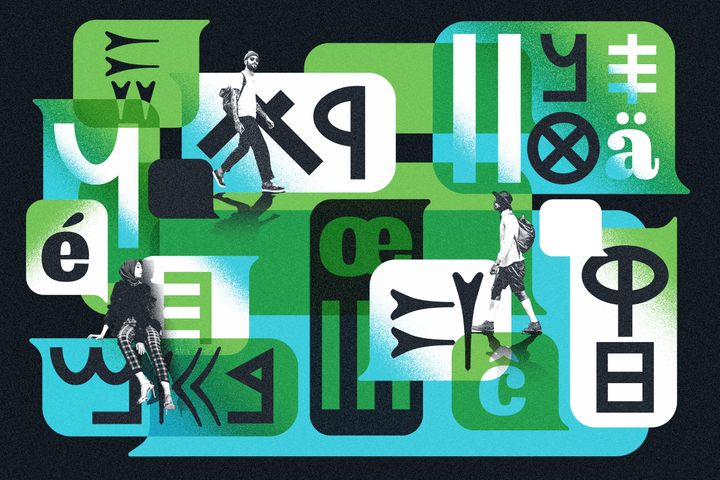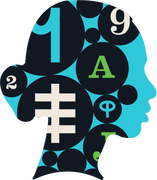
Puzzle Monday: A Divine Script From the Congo
Editor’s Note, November 2024: Thanks for checking out our puzzle archive! While the online version of this puzzle is no longer interactive, we suggest downloading the PDF, available below. You can find other archived puzzle PDFs available for download here.
Among our crosswords and other puzzles, we’ll be featuring linguistic challenges from around the world from puzzle aficionado and writer Alex Bellos. A PDF of the puzzle, as well as the solution, can be downloaded below.
Staring at a wall is not usually considered an inspirational activity. Indeed, the phrase is common shorthand for the paralysis of boredom.
For Wabeladio Payi, however, staring at a wall was life-changing. In 1978, the 21-year-old car mechanic looked at the brick wall of his home, saw the shapes of a “5” and a “2” in the contours between the bricks, and used the elements as the basis of a new writing system. The script he developed, Mandombe, is now understood by up to 10,000 people in the Democratic Republic of the Congo (DRC), the Republic of the Congo, and Angola.
Since the 19th century, many Africans have constructed scripts for their languages. The motivation has sometimes been linguistic and practical, to capture the local phonetics better than the imported Latin or Arabic alphabet. On other occasions it has had a political motive, a rejection of colonialism and the writing systems it imposed.

Mandombe is unusual not only because it is one of only two or three modern African scripts in active use, but also because it inspired by a divine revelation. On the night of March 13, 1978, Payi had a dream in which the prophet Simon Kimbangu came to him. Kimbangu was a Christian preacher who, in 1921, founded a movement that now has an estimated 20 million followers, mostly in the DRC. In the vision, Kimbangu told Payi to go to Nkamba, the holy city of Kimbanguism, where he would receive a sacred mission. It was just after the return from this pilgrimage that Payi found himself confronted with that fateful brick wall. Payi, whose grandfather was an early follower of Kimbangu, was brought up Catholic but became a Kimbanguist after his revelatory dream.

Mandombe—it means “for the Blacks”—is used to write Lingala, Kikongo ya leta, and Swahili, which are three of the nationally recognized languages in the DRC (alongside Luba-Kasai and French). It is a syllabary, meaning that each block represents a syllable, usually a consonant and a vowel together. Each symbol contains either the “5” or “2” shape (mirror images of each other), in addition to other angular lines that give the writing its distinctive look.
Payi’s invention has gained traction within the Kimbanguist church, where communities have set up their own script-learning centers called CENA, the French acronym for the Centre for Black-African Writing. Mandombe is also taught at Kimbanguist primary and secondary schools in the DRC, the Republic of the Congo and Angola, and at Simon Kimbangu University in Kinshasa. According to Helma Pasch, of the University of Cologne, Mandombe is believed to be “the only African script which has gained some social success without any political support.” She adds that it is also the script that has most benefited from the internet, which has enabled knowledge to spread through Congolese diasporic communities in Europe and North America.
Even though Mandombe writing is rarely seen in the streets of the cities in the DRC, several books are printed in it, mostly religious or educational titles. Patrick Kiasala Lukombo, coordinator in charge of Mandombe in Kinshasa province, says it takes between 12 to 24 sessions to learn how to read and write in it properly.

Robert Wazi Nandefo, a professor of geology at Bukavu University, is one of the most prominent advocates of the script, having run the ScriptMandombe Facebook Group since 2012. He says that the Congolese government has issued ministerial decrees to introduce the teaching of Mandombe writing in the universities of Kinshasa, Lubumbashi, and Kisangani.
“Mandombe is important for the RDC [the country’s French acronym], and all the Blacks in the world,” he says, “because in order for a people to develop you cannot use the tools of another people.
“Mandombe is important for me because it reflects the inventiveness of Africans and especially the Congolese. Wabeladio Payi demonstrated extreme intelligence,” he adds. It is Nandefo’s mission to make Mandombe known throughout world, particularly to Black people. “Mandombe writing will be adopted globally as the modern writing for Black people,” he says. “It will allow Africans to defend our continent and our riches, which are currently exploited and stolen by Westerners.”

Payi eventually became a professor at Simon Kimbangu University, where he taught classes in his invention. In 2011 he was given the title honoris causa at the University of Kinshasa. He died in 2013.
This puzzle presents some Kikongo ya leta words written in Mandombe, together with their transliterations in Latin letters and translations in English. Your task is to match the Mandombe to their transliterations.

Stumped? Download the solution, with all the logical steps to get there!










Follow us on Twitter to get the latest on the world's hidden wonders.
Like us on Facebook to get the latest on the world's hidden wonders.
Follow us on Twitter Like us on Facebook